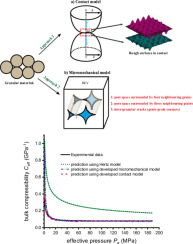当前位置:
X-MOL 学术
›
Acta Mater.
›
论文详情
Our official English website, www.x-mol.net, welcomes your feedback! (Note: you will need to create a separate account there.)
Pressure-dependent bulk compressibility of a porous granular material modelled by improved contact mechanics and micromechanical approaches: effects of surface roughness of grains
Acta Materialia ( IF 9.4 ) Pub Date : 2020-04-01 , DOI: 10.1016/j.actamat.2020.01.063 Lei Wang , Georg Dresen , Erik Rybacki , Audrey Bonnelye , Marco Bohnhoff
Acta Materialia ( IF 9.4 ) Pub Date : 2020-04-01 , DOI: 10.1016/j.actamat.2020.01.063 Lei Wang , Georg Dresen , Erik Rybacki , Audrey Bonnelye , Marco Bohnhoff

|
Abstract The change of the mechanical properties of granular materials with pressure is an important topic associated with many industrial applications. In this paper we investigate the influence of hydrostatic pressure (Pe) on the effective bulk compressibility (Ceff) of a granular material by applying two modified theoretical approaches that are based on contact mechanics and micromechanics, respectively. For a granular material composed of rough grains, an extended contact model is developed to elucidate the effect of roughness of grain surfaces on bulk compressibility. At relatively low pressures, the model predicts that the decrease of bulk compressibility with pressure may be described by a power law with an exponent of -1/2 (i.e., Ceff ∝Pe−1/2), but deviates at intermediate pressures. At elevated pressures beyond full contact, bulk compressibility remains almost unchanged, which may be roughly evaluated by continuum contact mechanics. As an alternative explanation of pressure-dependent bulk compressibility, we suggest a micromechanical model that accounts for effects of different types of pore space present in granular materials. Narrow and compliant inter-granular cracks are approximated by three-dimensional oblate spheroidal cracks with rough surfaces, whereas the equant and stiff pores surrounded by three and four neighboring grains are modeled as tubular pores with cross sections of three and four cusp-like corners, respectively. In this model, bulk compressibility is strongly reduced with increasing pressure by progressive closure of rough-walled cracks. At pressures exceeding crack closure pressure, deformation of the remaining equant pores is largely insensitive to pressure, with almost no further change in bulk compressibility. To validate these models, we performed hydrostatic compression tests on Bentheim sandstone (a granular rock consisting of quartz with high porosity) under a wide range of pressure. The relation between observed microstructures and measured pressure-dependent bulk compressibility is well explained by both suggested models.
中文翻译:

通过改进的接触力学和微机械方法模拟的多孔颗粒材料的压力相关体积压缩性:颗粒表面粗糙度的影响
摘要 颗粒材料力学性能随压力的变化是与许多工业应用相关的重要课题。在本文中,我们分别应用两种基于接触力学和微观力学的改进理论方法,研究静水压力 (Pe) 对颗粒材料的有效体积压缩率 (Ceff) 的影响。对于由粗糙颗粒组成的颗粒材料,开发了一种扩展接触模型来阐明颗粒表面的粗糙度对整体可压缩性的影响。在相对较低的压力下,该模型预测体积可压缩性随压力的降低可以用指数为 -1/2 的幂律来描述(即 Ceff ∝Pe-1/2),但在中间压力下会出现偏差。在超过完全接触的高压下,体可压缩性几乎保持不变,这可以通过连续接触力学进行粗略评估。作为对与压力相关的体积压缩性的另一种解释,我们建议使用一种微机械模型来解释颗粒材料中存在的不同类型孔隙空间的影响。窄而柔顺的晶间裂纹近似为具有粗糙表面的三维扁球状裂纹,而由三个和四个相邻晶粒包围的等长且坚硬的孔隙被建模为横截面为三个和四个尖角的管状孔隙,分别。在这个模型中,随着压力的增加,粗壁裂纹逐渐闭合,体积压缩性大大降低。在超过裂缝闭合压力的压力下,其余等量孔的变形对压力基本上不敏感,体积压缩性几乎没有进一步变化。为了验证这些模型,我们在很宽的压力范围内对 Bentheim 砂岩(一种由高孔隙率的石英组成的粒状岩石)进行了静水压测试。两种建议的模型都很好地解释了观察到的微观结构与测量的压力相关的整体压缩率之间的关系。
更新日期:2020-04-01
中文翻译:

通过改进的接触力学和微机械方法模拟的多孔颗粒材料的压力相关体积压缩性:颗粒表面粗糙度的影响
摘要 颗粒材料力学性能随压力的变化是与许多工业应用相关的重要课题。在本文中,我们分别应用两种基于接触力学和微观力学的改进理论方法,研究静水压力 (Pe) 对颗粒材料的有效体积压缩率 (Ceff) 的影响。对于由粗糙颗粒组成的颗粒材料,开发了一种扩展接触模型来阐明颗粒表面的粗糙度对整体可压缩性的影响。在相对较低的压力下,该模型预测体积可压缩性随压力的降低可以用指数为 -1/2 的幂律来描述(即 Ceff ∝Pe-1/2),但在中间压力下会出现偏差。在超过完全接触的高压下,体可压缩性几乎保持不变,这可以通过连续接触力学进行粗略评估。作为对与压力相关的体积压缩性的另一种解释,我们建议使用一种微机械模型来解释颗粒材料中存在的不同类型孔隙空间的影响。窄而柔顺的晶间裂纹近似为具有粗糙表面的三维扁球状裂纹,而由三个和四个相邻晶粒包围的等长且坚硬的孔隙被建模为横截面为三个和四个尖角的管状孔隙,分别。在这个模型中,随着压力的增加,粗壁裂纹逐渐闭合,体积压缩性大大降低。在超过裂缝闭合压力的压力下,其余等量孔的变形对压力基本上不敏感,体积压缩性几乎没有进一步变化。为了验证这些模型,我们在很宽的压力范围内对 Bentheim 砂岩(一种由高孔隙率的石英组成的粒状岩石)进行了静水压测试。两种建议的模型都很好地解释了观察到的微观结构与测量的压力相关的整体压缩率之间的关系。


























 京公网安备 11010802027423号
京公网安备 11010802027423号